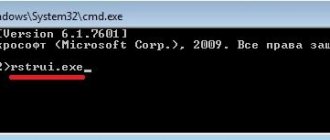If you've been using Windows 10 for a while, you may have noticed that pressing F8 or SHIFT+F8 on your keyboard to enter Safe Mode no longer works. This method stopped working because the Windows 10 startup procedure is faster than ever before. However, this does not mean that Windows 10 does not have a safe mode. It's just that to get there you need to do something different. Below we will tell you how you can start Windows 10 in Safe Mode.
What is Booting into Safe Mode in Windows 10
When you boot into Safe Mode in Windows 10, the operating system displays a minimal user interface and only requires basic services and drivers. This mode makes troubleshooting easier because it doesn't download files that could cause Windows to crash.
If you want to know all the methods you can use to start Windows 10 in Safe Mode, read this guide until the end. First, we'll cover what to do if you can't log into Windows 10 anymore, and then what to do when you can in Windows 10. If you can't boot into Windows 10, read Methods 1 to 4. If you can log into Windows 10, reading methods 5 to 7. The eighth method only works on computers with older hardware.
You can also enable the mode in Windows 8 in 4 different ways
The first two are described in detail at the beginning of the article. The other two are quite similar to the options that are suitable for Windows 10, but we will still look at them in more detail to make it easier for you to navigate.
Diagnostic tools
So, the first method is to activate the buffer format (only suitable if the OS is working normally). To do this we do the following:
- Click the “Options” button (located on the sidebar), select “Shutdown”, then hold down Shift and select “Reboot”. This will launch the diagnostic screen.
- In the new window, select: Diagnostics – Additional. options – Boot options – Reboot.
- Next, the system will ask you to select the desired download method. The standard option (4th point) is suitable here, so press F4.
The PC will start in Safe Mode, and you can carry out the necessary manipulations.
Boot from disk or USB flash drive
And another simple option for launching safe mode in Windows 8 is using a bootable flash drive or DVD with Windows files. The procedure is as follows:
- Connect a USB flash drive (or disk) and boot from the media.
- A window for setting the date and time will appear - click “Next”.
- When the installation window opens, select “System Restore”. As a result, the diagnostic screen will appear (it is slightly different from the previous option).
- Next, select the items: Diagnostics – Additional. parameters – Command line.
- In a new window, enter: bcdedit / set globalsettings and press Enter.
- After eliminating all errors, write the line in the command editor - bcdedit /deletevalue {globalsettings} advancedoptions. This will disable the transition to the diagnostic screen when you turn on the OS.
- Close it and click “Continue”.
- After rebooting, the system will prompt you to select a boot method - click F4. The PC will now turn on in Safe Mode.
Good to know: How to remove the password when turning on Windows 8?
Use "Shift + Restart" on Windows 10 login screen
If you can't log into Windows 10 but can get to the login screen, press and hold the SHIFT key on your keyboard. When you press this key, press or tap the Power button, and in the menu that opens, tap Restart.
Booting into Windows 10 Safe Mode from the Login Screen
Windows 10 will restart and ask you to select an option. Select Troubleshoot.
Troubleshooting Windows 10
On the Troubleshooting screen, navigate to Troubleshooting.
Access advanced troubleshooting options
On the Advanced Options screen, select Startup Options. Depending on your Windows 10 computer, you may not see this option at first. If you don't, click or tap the link that says "Learn more about recovery options."
Finally, click on “Launch Options”.
Windows 10 startup settings
Windows 10 says you can restart your device to change advanced boot options, including enabling Safe Mode. Click Restart.
Windows 10 Boot Settings
After Windows 10 restarts, once again you can choose which boot options you want to enable. To get into Safe Mode, you have three different options:
- Standard Safe Mode - Press the 4 button or F4 key on your keyboard to launch it;
- Safe mode using networking - press 5 or F5;
- Safe Mode with Command Prompt - Press either 6 or F6.
List of boot options in Windows 10
Enter Windows 10 Safe Mode with a user account with administrator rights and make the necessary changes.
How to enable on Windows 10
Let's look at the main activation methods on the latest version of the popular OS - WIndows 10.
Reboot with SHIFT key
This is probably the simplest method, as it only requires a few steps:
- Open the Start .
- Click on the computer shutdown icon.
- SHIFT key on your computer and click Restart .
After this, the computer will turn off and start in safe mode.
MSCONFIG
If the previous method turned out to be useless, use a special Windows utility:
- Press the Win+R to open the command interpreter.
- In the window, type msconfig and press Enter .
- The System Configuration window will appear with several tabs.
- Select Download .
- There, click on the desired OS, if you have two of them.
- Set the checkbox to "Safe Mode" .
- Click "Apply" , "OK" .
- Confirm to restart your computer.
Command line
For those who don't like simple methods, the command line method is suitable:
- Launch the cmd and enter the following code there: bcdedit /copy {current} /d “Any name.”
- Now open msconfig , to do this, press Win+R , and enter msconfig .
- In the "Downloads" , select a new item with your name and restart your computer.
F8 key
This method has been removed from the system by the developers. However, you can return it manually:
- Run Command Prompt as Administrator.
- Copy and paste the code: bcdedit /deletevalue {current} bootmenupolicy.
- Press Enter .
- Close CMD and restart your PC.
- During system startup, quickly press F8 , in additional boot options there will be a safe mode.
Special download methods
- Right-click on the Start .
- Select "Options" .
- There, select the section "Update and Security" .
- Next, go to "Recovery" .
- Click on the gray “Reboot Now” .
- When the menu appears, press the desired button on the keyboard.
Windows 10 distribution
If the previous methods do not work, there is another one; for it you will need a flash drive or disk with the Windows 10 installer:
- Install the distribution media into your computer, restart the PC and in the BIOS select boot from the desired drive.
- When the Windows Setup , click Next .
- Select "System Restore" in the lower left corner.
- Open Troubleshooting .
- Click on "Command Line" .
- In the console, enter the command bcdedit /set {default} safeboot minimal.
- Press Enter and restart your PC.
Interrupt the normal Windows 10 boot process three times in a row
If Windows 10 fails to boot normally three times in a row, open the fourth time, which is when it starts in Automatic Repair mode by default. Using this option, you can boot into Safe Mode. To run Automatic Repair mode, you must interrupt the normal boot process three times in a row: Use the Reset or Power button on your Windows 10 PC to stop it mid-boot before it finishes booting Windows 10. If you use the button "Power", you may need to hold it down for at least 4 seconds to turn off the power. When Windows 10 enters Automatic Repair mode, the first thing you see is a screen that says the operating system is “Preparing Automatic Repair.”
Preparing automatic recovery for Windows 10
You may then be asked to select an account to continue. Select an account with administrator rights and enter its password. If you are not asked for this information, continue to the next step.
Windows 10
The usual algorithm, which requires pressing F8, does not work in the latest editions of Windows. However, this version of the OS has many more ways to launch Safe Mode than previous ones. The first method requires that the OS be operational.
- Click the Action Center icon. Open All Settings. Go to "Update and Security". In the left block of the window, click on the text “Recovery”. Click on "Reboot".
- In the window that opens, click one by one on the following items “Diagnostics” - “Basic settings” - “Boot options”. Click on the words “Restart”.
- Before restarting the computer in safe mode, in the expanded screen you must press F4, F5 or F6 on the keyboard.
If the Windows desktop does not start, you can open the boot options from the password screen. To do this, click on the power icon in the lower right corner. Press SHIFT and click on “Reboot”.
Use Windows 10 installation disc and command line
If you have a Windows 10 setup DVD or USB drive installed, or if you can create one right now, you can use it to boot your broken Windows 10 PC into safe mode. To create a Windows 10 installation media, follow this guide on another PC: How to Create Windows 10 Installation Media (USB Drive) or Download a Free ISO File. Then use it to boot your broken Windows 10 PC and wait for the installation environment to load. Select the language and keyboard layout you prefer and click or tap Next.
Setting up Windows 10
Click or tap the link that says "System Restore" in the bottom left corner of the screen.
Windows 10 System Restore
When asked which option you prefer, select Diagnostics.
Diagnostics menu in Windows 10
On the Advanced Options screen, click or tap Command Prompt (Use Command Prompt for advanced troubleshooting).
Launching the Command Prompt in Windows 10
In the command prompt window, enter the command: bcdedit /set {default} safeboot minimum. Press Enter on your keyboard and after some time it tells you that "the operation completed successfully."
Activating Safe Mode from the Command Prompt in Windows 10
Close Command Prompt and click Continue on the next screen.
Continuing to work with Windows 10
After you restart your computer, Windows 10 enters safe mode. Log in with a user account that has administrative rights and make the necessary changes.
Important: The problem with this method is that it tells Windows 10 to automatically enter Safe Mode every time you start it until you tell it to. To disable this setting and start Windows 10 again, follow the same procedure again and enter the command: bcdedit /deletevalue {default} safeboot.
What to do if safe mode does not start on Windows
Don't know what to do if Windows won't boot into safe mode? The reasons will help you understand why this happens. Reasons why safe mode does not start:
- Virus software
- Hardware power failure
- File system corruption
- Technical difficulites
If safe mode does not work, try using the AVZ utility.
- How to start acer safe mode. How to start safe mode on an Acer laptop
If the program still does not boot Windows into safe mode, perhaps changing the system configuration will help.
If you have tried all the methods, but safe mode still does not turn on, then the most radical method remains - reinstalling Windows.
Boot from a USB flash drive for Windows 10
In Windows 10, you can create a USB drive for system recovery. Since your computer may not work, create this USB drive on another Windows 10 computer.
Creating a Windows 10 Recovery Disc
Once you have created the USB drive, use it to boot your Windows 10 PC or device and when asked to download its contents, do so. The first screen asks you to choose a layout for your keyboard. Select the one you want to use, or if you don't see it, click or tap View More Keyboard Layouts to get a full list of available layouts.
Selecting a keyboard layout for the recovery drive
After selecting the keyboard layout you want to use, on the Select an Option screen, go to the Troubleshooting section.
Troubleshooting Windows 10
The next steps you need to take to boot into Safe Mode are the same points we showed in the first method of this guide. Go to “Advanced options -> Startup options -> Restart”. Then press 4 or F4 to boot the keyboard into Minimal Safe Mode, press 5 or F5 to boot into Safe Mode with Networking, or press 6 or F6 to boot into Safe Mode with Command Prompt.
Boot method 2. Via MSConfig
You can launch diagnostic mode directly from Windows.
Step 1 : Launch MSConfig.
- Click Start and Run.
Open the “Start” menu, find and click on “Run”
- A window will appear in which you need to type “msconfig”. After this, confirm the action with the “OK” button.
In the “Open” field, type the command “msconfig”, click “OK”
Step 2: Open "BOOT.INI". In the open “System Configuration Utility” window, select the “BOOT.INI” tab.
Go to the “BOOT.INI” tab
Step 3: Select "/SAFEBOOT". Check the box next to the “/SAFEBOOT” option and select one of four options:
- “MINIMAL” – launch normal safe mode;
- “NETWORK” – launching safe mode with network access;
- "DSREPAIR" - Prevents data loss if a blue screen occurs during normal booting.
- “MINIMAL (ALTERNATESHELL)” – launch in safe mode with an alternative graphical shell (by default this is the command line).
Check the box next to the “/SAFEBOOT” option, select and check one of the boot options, click “Apply”, then “OK”
Step 4. Click on the “Reboot” option. After reboot, Windows XP will automatically launch the selected mode.
Click the “Reboot” button
Attention! To boot into the OS in normal mode, you need to uncheck “SAFEBOOT”, otherwise you will continue to boot into Safe mode.
Uncheck the “SAFEBOOT” option, click “Apply”, then “OK”
Video - How to enter safe mode in Windows 7 (XP)
Use the System Configuration tool (msconfig.exe) to enable Safe Mode
If you can get into Windows 10, one of the easiest ways to boot into Safe Mode is to use the System Configuration tool. Many users know this tool by its file name: msconfig.exe.
In the search field from the taskbar, enter the words "System Configuration". Then click or tap the System Configuration shortcut. Other ways to run this tool are described here: 8 Ways to Run System Configuration on Windows (All Versions).
system configuration
In the System Configuration window, click or tap the Boot tab. Under Boot Options, select Secure Boot. Finally, click or tap OK.
Selecting Secure Boot in System Configuration
Windows 10 tells you that you need to restart your computer for the new settings to take effect. If you still have work to do, you can select "Exit without restarting." If not, you can restart now and your device will automatically boot into Safe Mode.
System configuration request for reboot
After Windows 10 restarts, it goes into safe mode.
Running in Safe Mode via System Configuration
To open the System Configuration window, press the key combination + R , enter the msconfig and click Ok.
A window will open in which we go to the “Download” tab. If you have several operating systems installed (like me, in the screenshot below), then select the one you need, check the box next to “Safe Mode”, Click the “Apply” and “Ok” button.
There are boot parameters that can also be changed:
- Minimum – normal safe mode with loading only the most necessary drivers.
- The other shell is safe mode with command line support.
- Network is a mode that loads network drivers (network support).
After clicking “Ok”, the computer will ask you: exit without rebooting, or reboot. You may agree. After rebooting, when you turn off your computer, Windows 10 will boot into safe mode.
To disable this feature later and boot the system as usual, in the system configuration settings window, uncheck the box next to the “Safe Mode” item.
As you can see, this is a very simple and working method.
Use "Shift + Restart" in Windows 10 Start Menu
Another way to enter Safe Mode in Windows 10 is to use the options found in the Start menu. Press and hold the SHIFT key on your keyboard. With this key pressed, press the Start button, then Power, and then Restart.
Launching Safe Mode from the Start menu in Windows 10
Windows 10 reboots and asks you to select an option. Select Diagnostics.
Diagnostics
Then you have to follow the same steps as in the first method from this tutorial. In short, go to "Advanced options -> Startup options -> Restart". Then press 4 or F4 on your keyboard to launch into Safe Mode, press 5 or F5 to boot into “Safe Mode with Networking,” or press 6 or F6 to enter “Safe Mode with Command Prompt.”
Types of Safe Mode
There are several types of safe mode:
| Type 1 safe mode | This is the main type, thanks to which a clean Windows starts up along with the most necessary drivers. |
| Safe mode with loading network drivers | If you need the Internet to work in safe mode, choose this type. |
| Safe Mode with Command Prompt | This view is for advanced users who understand console commands. Instead of a graphical interface there will be a command line. |
Use F8 or Shift+F8 (does not work when using UEFI BIOS drives and SSDs)
In Windows 7, you were able to press F8 before Windows booted to open the Advanced Boot Options window, where you can choose to start Windows 7 in Safe Mode. Some websites advise you to press Shift + F8 just before you boot into Windows 10 so that you launch Recovery Mode from where you can boot into Safe Mode. The problem is that in most cases, Shift + F8 and F8 do not work, although they are valid commands supported by Windows 10.
SHIFT and F8 keys on the keyboard
This official blog post from Microsoft explains that this is due to their work to create a fast boot procedure. Both Windows 8.1 and Windows 10 have the fastest boot times. To quote Steve Sinofsky:
“Windows 8 has a problem - it can actually load too quickly. So in reality, there is no more time to interrupt the download. When you turn on a Windows 8 computer, there is no longer enough time to detect keystrokes like F2 or F8, much less time to read a message such as “Press F2 to install.” For the first time in decades, you will no longer be able to interrupt the boot and tell the PC to do anything other than what was already expected.”
If you have a modern PC with UEFI BIOS and a fast SSD drive, you cannot interrupt the boot procedure using your keyboards. On older PCs with a classic BIOS and no SSD, pressing these keys may still work.
Safe Mode Using the System Configuration Utility
NB
Do not use this method if your computer is infected.
Press Windows
+
R
.
The Run
dialog box appears .
Type msconfig and click OK
.
You will then be prompted to restart your computer. Click and the computer will boot into safe mode.
After that, search and troubleshoot. Once the malicious files are removed in Safe Mode, repeat steps 1-5, but in step 4, uncheck the box. Close all programs and restart your computer again.











